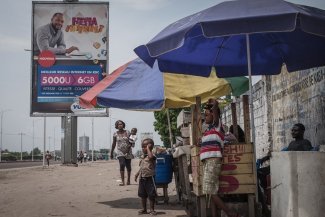
The ASIT provides families like that of Julio Zamora with computers and help to develop their digital literacy skills.
[This article was first published on Equal Times on 30 May 2018]
It is difficult to predict how many people will read this report, but what we can be sure of is that around four billion people will not.
Nor will they do their next bank transfer from their mobile, or get a cheap last-minute flight, or apply from home for the thousands of job offers that will be published today.
They are disconnected, at the antipodes of the Amazon Prime accounts, excluded from the global conversation, for want of technology, money and education. The huge gap dividing the world into the half that spends more hours online than asleep and the other that thinks that the cloud is simply water vapour is now digital.
The divide mainly affects developing countries (60 per cent of the disconnected population lives in Asia and 18 per cent in Africa), but it also divides those with the highest per capita income in two. Currently, 15 per cent of Europeans do not have access to the internet. People like Julio Zamora.
“I used to have to queue for hours to use the computer at the library to be able to make an appointment with the doctor, otherwise I would have to go to the car park of the shopping centre and pick up a Wi-Fi signal there.” Julio lives with his wife and three children in Palmilla – one of the most economically depressed neighbourhoods in Malaga – and until recently the only technological device in their home was a mobile phone with no data plan.
Being on the wrong side of the divide means scouring cafés and shopping centres for open networks, putting up with long waits to sort out a simple administrative procedure, going from company to company to submit your CV by hand and being turned down because you cannot send it by email.
“The internet was designed to improve our quality of life, but the more things progress, the more electronic services there are, the more people are being left behind,” says Tomás Pérez, from an association dedicated to research and technology, Asociación al Servicio de la Investigación y la Tecnología (ASIT). The collective first came to Palmilla 20 years ago. A quarter of its residents were living on the poverty line at the time, seven out of ten were unemployed, and eight per cent did not even know how to read. “When we said we wanted to tackle the digital divide, everyone looked at us as if we were from another planet. For them, the internet was a luxury.
They started going to various companies and picking up old computers that were about to be thrown out. They would recycle them, repair them and offer them to families. They have since then provided around 100 homes with computers, including Julio’s. “But we solve nothing by simply handing out computers,” explains Pérez. “We also have to provide training so that they can put them to good use.”
Researchers such as sociologist Stefano de Marco distinguish between the digital divide and digital inequality. The divide marks the difference between those who have access to the internet and those who do not, whereas inequality is related to its use.
“In the West, the divide is gradually narrowing. In Spain, for instance, 84.6 per cent of the population already has access to the internet, whereas five years ago the figure was just 65 per cent,” explains De Marco, “The problem is the use that is made of it.”
According to a study conducted by Orange in 2014, only 46 per cent of low-income families use the internet to deal with administrative procedures and just 23 per cent use it for purchases or banking transactions. High-income families make almost three times more use of these services.
“People with more economic difficulties tend to connect less and, moreover, only tend to use it for entertainment,” insists the sociologist. That is what digital inequality means. Only a section of the population is able to enjoy the advantages of the internet (accessing knowledge, saving time, buying things more cheaply, etc) And it is this segment that is already the most privileged.
Digital orphans
According to UNICEF’s The State of the World’s Children 2017, 346 million so-called ‘digital natives’ do not, in fact, have access to the internet. It is “yet another dividing line” between advantaged and disadvantaged children.
Even in countries such as Spain, where three out of every four children have a mobile phone, their socio-economic status once again marks the difference. Children from families with more resources use the net more to look for information, to do homework and to read than children with more modest family backgrounds. The problem is simply that the latter do not have the knowledge, skills and the social context to help them.
“They say they are ‘digital natives’ but they are in fact ‘digital orphans’. They learn to use the technology on their own, such as with Instagram or Snapchat. They need to be taught how to put the technology to good use.” This view is expressed by Rosa Liarte, a secondary school teacher.
She uses tools on a daily basis to create eBooks, applications to edit online content, Google maps, etc. “We suggest that they bring their own mobile device. Most of them have a mobile phone, a tablet or a laptop. If not, the school lends them one.”
But her experience is not typical. Forty per cent of teachers still do not incorporate technology into their classes, be it for want of equipment or training.
“The world of internet is evolving at a dizzying pace and schools do not know how to handle it. There are major differences from one school to the next, in some the use of tablets is compulsory and in others talking about technology is like talking about science fiction,” says researcher Estefanía Jiménez, who specialises in audiovisual literacy and the use of social media. She insists, for this reason, on the need to invest in education. Not only because some pupils are at a disadvantage, but also because the lack of digital skills exposes them to greater risks.
“It’s a matter of warning them about new threats such as cyber-bullying or hate speech on the net.”
“The internet reflects existing inequalities”
Over 90 per cent of the jobs currently created in the European Union require technological skills. The internet is not a luxury, it’s the difference between getting a job or ending up marginalised in a world full of screens, between inheriting poverty or having a better life than your parents.
It is for this reason that CSIC (the Spanish National Research Council) researcher José Manuel Robles is pressing for this technology to be defined as a “non-optional public good”. He is calling for internet learning to be universal and compulsory, like elementary education. “The digital divide and digital inequality should be considered as a social problem,” argues Robles, because they contribute to heightening other inequalities.
Sociologist Stefano de Marco likens it to a mirror. “The internet reflects existing inequalities; it also often acts like a wedge. It helps to further augment the differences.” To fully understand it, you simply have to look back at the beginning of this report.
If those who already have resources learn to take better advantage of the internet, this then helps them to accumulate even more resources and the difference with those who have less increases. Over time, it will become almost unbridgeable. A kind of technological apartheid will emerge.
According to De Marco, there is only one way of avoiding this: “By applying an aggressive policy ensuring equality of use, access and skills from an early age for the new generations. They are the only hope.”
In the case of Julio Zamora, a change is already being noticed. Since their first computer was installed, the children are doing better at school. “Especially with maths and languages,” says Julio. “What I want for them is to learn, to study, for them to be able to compete for a job with anyone in the future.”









